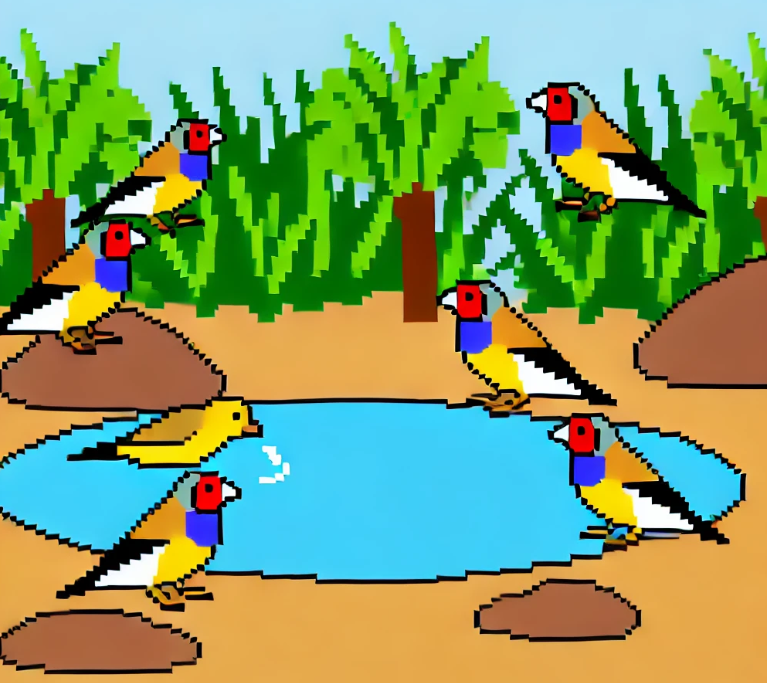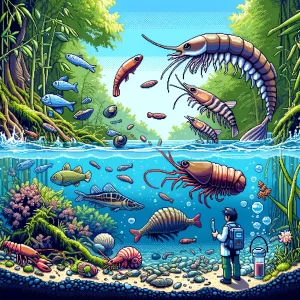
Vigilant Finches: Balancing Safety and Survival
Imagine a tranquil waterhole in the heart of Australia’s tropical savannah. It’s early morning, and the air is filled with the melodic chirping of Gouldian finches. These colorful birds are not just enjoying a refreshing drink; they are constantly on high alert. Their vigilant behavior at waterholes reveals fascinating insights into how animals balance the need to hydrate with the constant threat of predators.
Understanding Vigilance in Animals
Vigilance, the act of being watchful for potential danger, is crucial for survival in the wild. For many animals, waterholes are both a lifeline and a danger zone. Predators know that prey must come to drink, making these spots risky. But how do animals like the Gouldian finch manage this risk?
The Study: Gouldian Finches at Waterholes
A recent study focused on the vigilance behavior of Gouldian finches at waterholes in Northern Australia’s Kimberley region. The research aimed to understand how environmental and social factors influence these birds’ watchfulness.
The Gouldian Finch: A Brief Introduction
Gouldian finches are small, vibrantly colored birds native to Australia’s tropical savannahs. They come in three head color morphs: black, red, and the rare yellow. These colors are not just for show; they signal different personalities and behaviors. Black-headed birds are less aggressive and more cautious, while red-headed birds are bolder and quicker to explore new environments.
Why Waterholes?
During the dry season, water becomes scarce, and finches must visit waterholes daily. These visits are perilous due to the constant threat of predators like falcons and goshawks. Understanding how finches remain vigilant in such high-risk areas can shed light on their survival strategies.
Key Findings from the Study
Waterhole Size Matters
The size of the waterhole significantly affects finch vigilance. Smaller waterholes, which offer fewer safe drinking spots and higher competition, make finches more watchful. In these confined spaces, predators can easily target prey, leading to heightened alertness among the birds.
The Role of Cover
Trees around the waterholes provide varying levels of cover. Finches in open, leafless trees exhibited higher vigilance compared to those in trees with dense foliage. This behavior aligns with the refuge vigilance hypothesis, suggesting that birds feel safer and less exposed in covered areas.
Social Dynamics
The number of birds in a group also influences vigilance. Solitary finches were the most vigilant, while those in larger groups were less so. This supports the “many eyes hypothesis,” where larger groups provide better surveillance, reducing the need for each bird to be on constant lookout.
Interestingly, group composition affected vigilance too. Birds in groups of mixed head colors (e.g., black-headed and red-headed together) showed lower vigilance than those in groups of the same head color. This finding suggests that mixed groups may benefit from different vigilance strategies, potentially confusing predators or enhancing overall group safety.
Individual Differences
Age and sex also played roles in vigilance. Juveniles were more vigilant than adults, possibly due to their inexperience and higher perceived threat levels. This mirrors findings in other species where younger animals tend to be more cautious.
The Bigger Picture: Implications and Future Directions
The study’s findings have broader implications for understanding animal behavior and survival strategies in changing environments. With global warming leading to more frequent and prolonged dry seasons, waterholes will become even more critical—and dangerous—for wildlife.
Heightened vigilance at smaller, more crowded waterholes could lead to increased stress and competition among finches. This stress might affect their overall health and breeding success, potentially impacting the species’ survival.
Conclusion: Staying Alert in a Changing World
The vigilance of Gouldian finches at waterholes is a delicate balance between staying safe and quenching their thirst. By understanding these behaviors, we can better appreciate the complexities of animal survival in the wild. This knowledge is vital as we face environmental changes that threaten these beautiful birds and many other species.
What do you think?
- How might climate change impact the behavior and survival of Gouldian finches and other wildlife dependent on waterholes?
- What conservation strategies could be implemented to protect species like the Gouldian finch in increasingly hostile environments?
Explore and Learn with Science:
Dive into groundbreaking research and inspiring stories with ‘This Week in Science’! Perfect for teachers and science enthusiasts, our free weekly newsletter expands your horizons in teaching and learning. Join us today and reshape your engagement with science.



